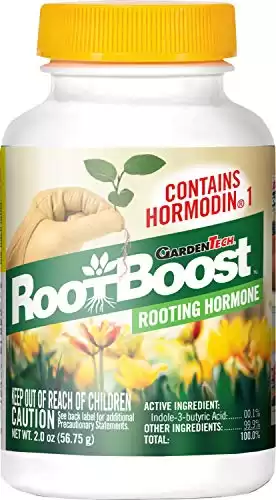Nurserymen and plant propagation specialists have long used the Rootone root hormone as a “secret weapon” in rooting cuttings.

When rooting cuttings, the famous “one dip” Rootone powder rooting compound gives cuttings a faster start, helping them achieve stronger, healthier root growth and development than ever before.
Because Rootone for plants (often misspelled as root tone powder) includes an added fungicide, it helps prevent “damping off, “ root rot, and other soil-borne diseases.

You can pick up a bottle of dry Rootone rooting powder or other brands of root hormone for plants at most major garden centers or online at Amazon.
It costs pennies to treat 100’s of plant cuttings! Try root tone for plants yourself and see the results!
Quick Propagation Tips On Cuttings And Using A Rooting Hormone
Here’s how to use the rooting hormone powder.
When it’s time to propagate your favorite plants, we usually think of hardwood cuttings and softwood cuttings.

A cutting may be a single leaf used for the propagation of African violets, Fuchsia plant cuttings, or a terminal “slip” from a begonia, geranium, or similar plant.
Use a sharp knife or razor blade to remove cuttings from the parent plant.
The leaf cuttings need one-half to one inch of stem (called the “petiole”); do a quick dip of the “cutting” into the hormone powder.
Knock off the excess rootone hormone powder before inserting the base of the leaf in the rooting medium.

Stem cuttings are usually 3″ to 6″ inches long; cut them from the stem at about one-fourth to one-half inch below a node (leaf joint).
Remove enough lower leaves so 1/3 to 1/2 of the stem can be inserted into the rooting medium.
Cuttings root well in sterile soilless medium potting mix such as coarse horticultural vermiculite.
Many backyard growers use a mixture of equal parts peat moss and vermiculite. Many old-timers still rely on clean, sharp sand kept nicely moist.
READ: Perlite vs Vermiculite – What is the Difference?

Once rooted, depending on the variety, transplant and grow as normal for that plant variety.
The video below shows the steps taken to root a hibiscus tree.
Note: Discovered in 1935, indole-3-butyric-acid and naphthalene acetic acid are found to be effective in rooting stem cuttings.

Both are the active ingredients in most commercially available rootone rooting hormone products.


